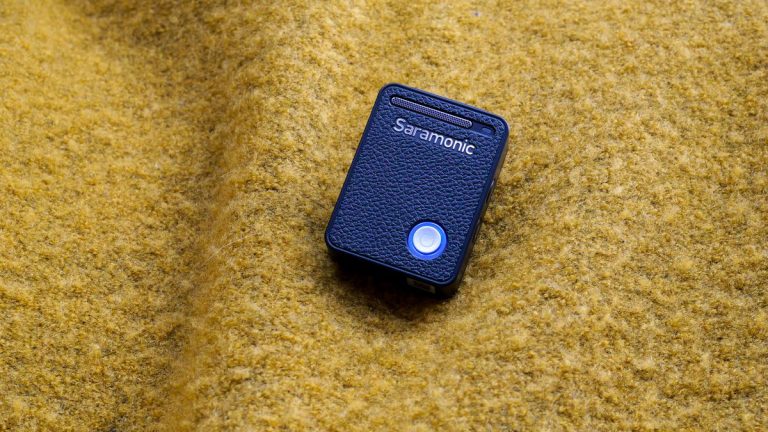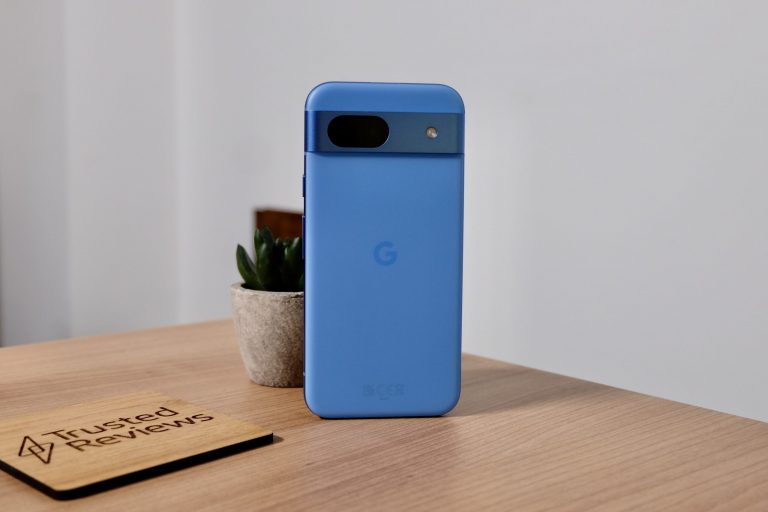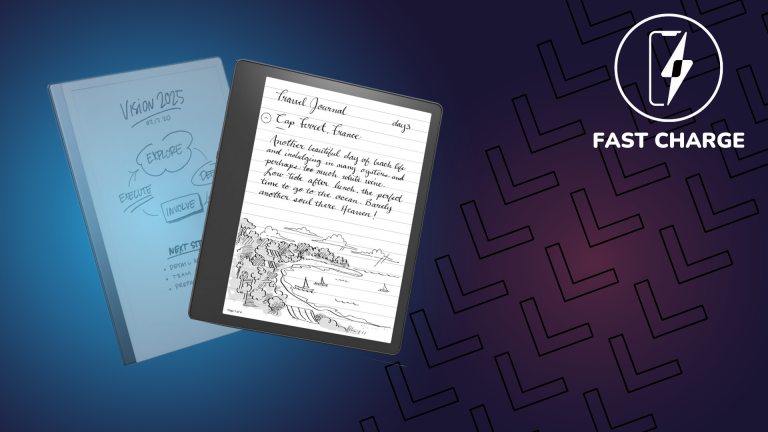All of Fairphone’s typical promises are back here in force: the fifth-gen mobile is easily repairable, with parts you can remove with a screwdriver and replace with equivalents bought via the brand’s store. The company is set to support the Fairphone 5 with at least five years of software updates, too, so you can keep using it for half a decade, at least. Plus, many of the parts used in the Fairphone 5’s design are from renewable sources, or reused from recycled phones.
So, for the Fairphone 5 – more so than any other mobile on the market – you can rest assured that you’re picking the greenest option.
That’s important because, besides the eco credentials, the Fairphone 5 is like its predecessors in that it’s not very competitive for its price. You can spend the same amount on another Android phone and get better cameras, a more powerful processor, or a bigger screen. So, you do need to balance these factors when considering this device.
What’s new here, and slightly surprising, is that Fairphone is eschewing its previous design choices. Previous phones from the brand have typically had specs on par with low-end or mid-range rivals, but the Fairphone 5 is grasping up towards the top end – a move it partly, but not wholly, pulls off.
That’s best illustrated with the cameras, as the front-facing and both rear sensors each sport a 50MP resolution, and you can see clear improvements in the handset’s AI scene optimization too. But the latter goes much too far on one of the cameras, resulting in ultra-wide snaps that are a hideous mess.
Not all of Fairphone’s premium attempts are as mixed a bag: the screen has seen a significant spec improvement, making it wonderful to watch content on, while the chipset is also a lot more powerful than we’ve typically seen in previous Fairphone handsets; you can finally play games without taxing the hardware too much.
The improvements across the board are matched with a fairly significant price hike over the Fairphone 4, to shift the Fairphone 5 into the premium territory.
It feels as though Fairphone is trying to court a new audience with its latest mobile, one which typically picks the new iPhone or Samsung Galaxy and wants top-end phones. This may work out, though it means some fans of the brand, those with limited funding, might be left behind.
Fairphone 5 review: price and availability
(Image credit: Future)
Went on sale in the UK & Europe in September 2023 £649 (roughly $800 / AU$1,250) for 8GB RAM & 256GB storage US availability is unlikely
The Fairphone 5 was announced at the end of August 2023 and released in September, roughly two years on from its predecessor. That follows Fairphone’s biennial cycle.
The handset costs £649 (roughly $800 / AU$1,250), which is a fair step up over the £499 (around $670, AU$930) entry price of the Fairphone 4, though that entry had a £569 (about $770, AU$1,060) equivalent with a more comparable 8GB RAM capacity and 256GB storage (this mobile received a price cut when the 5 was announced). Either way, you’re paying more for this phone than for its predecessor.
That price hike puts the Fairphone 5 much closer to – but not quite on par with – the likes of the Samsung Galaxy S23 and iPhone 15 . It lives in a no-man’s land between premium and mid-range mobiles, a category that doesn’t see as many entries as it should. As a result, this feels like a cost-saver’s alternative to the current batch of premium smartphones.
There’s no word on a US or Australian release date, but the Fairphone 4 was released in the US two years after it came out in Europe , so there is a chance that its successor could repeat that approach.
Fairphone 5 review: Specs The Fairphone 5 provides some spec increases over its predecessor, for a mixed bag of mid-range and premium features.
Swipe to scroll horizontally
Fairphone 5 specs
Header Cell – Column 1
Dimensions:
161.6 x 75.8 x 9.6mm
Weight:
212g
Screen:
6.46-inch FHD+ (2700×1224) 90Hz OLED, protected by Gorilla Glass 5
Chipset:
Qualcomm QCM6490
RAM:
8GB
Storage:
256GB
OS (at launch):
Android 13
Primary camera:
50MP, f/1.9
Ultra-wide camera:
50MP f/2.2 w/ 121º FoV
Front camera:
50MP f/2.5
Audio:
Stereo speakers
Battery:
4,200mAh
Charging:
30W wired
Colors:
Transparent, black, blue
Fairphone 5 review: design
(Image credit: Future)
Repairable and moddable design Made from sustainable and recycled materials Fairly chunky in the hand
Fairphone is harking back to the noughties with the design of its newest phone. The Fairphone 5 unit that we tested has a see-through back, so you can peer into the inner workings of the device (well, to its battery mainly, but that’s still something!). To my judgemental eyes, this isn’t quite as attractive a look as the olive green of the Fairphone 4 we previously tested, but luckily there are black and blue versions of the phone on sale too.
It’s fair to give Fairphone devices quite a lot of leeway when it comes to design, and that’s because they’re doing something quite different. The Fairphone 5 has a modular design that lets you remove and replace broken components, and it’s really simple to do, whether or not you’re an expert engineer. Plus, you can remove the back of the phone and battery with your hand (remember when all smartphones let you do that?).
This is a rugged phone too, one that’ll survive tough bumps or drops. It has a MIL-810H durability rating – that’s a military-grade standard, so you know it’s solid – and the phone also has IP55 certification against splashes and dust ingress. So, don’t take it for a dive, but this handset will survive all of life’s unexpected accidents otherwise.
I say all this to acknowledge the justification behind some of my issues with the phone’s design.
The Fairphone 5 is big and heavy, perhaps big and heavy enough to put off users with smaller hands. Measuring 161.6 x 75.8 x 9.6mm, and weighing 212g, this handset is surprisingly hefty, and we can imagine that some might not like the way it feels in the hand.
The phone has a USB-C port – no 3.5mm headphone jack, as Fairphone is one of the many brands to drop this – and on its right edge, it has two volume keys as well as a power button embedded in a fingerprint scanner. The sensor for this scanner is hair-pullingly unreliable, mind, and I often found myself rubbing my thumb on it as though it was a magic lamp about to grant me a wish.
Fairphone 5 review: display
(Image credit: Future)
6.46-inch Full HD+ display Bright and vibrant screen Big upgrade over the predecessor
The Fairphone 5 has a 6.46-inch display, so you’ve got more screen real estate than the 6.3 inches of the Fairphone 4, but that size increase is just one of the many improvements.
The display is OLED now, with Fairphone having ditched LCD, and it also has a higher refresh rate at 90Hz. There’s a maximum brightness of 880nits and a higher resolution of 1224 x 2700 too.
All of these changes combine to ensure that the Fairphone 5 is great for watching shows, scrolling through social media and playing games; with a noticeably better viewing experience across the board than its predecessors.
The display is broken up by a ‘punch-hole’ cut-out for the front camera, with Fairphone finally moving into the future and ditching the notch, and while this doesn’t really provide much of a user experience benefit (on this or any other phone!), it does give the Fairphone 5 a more modern look.
Fairphone 5 review: software
(Image credit: Future)
Stock Android 13 is nice and clean Five years of software upgrades 8-10 years of security updates
If you’re a fan of clean software, then you’ll like the Fairphone 5. Like the best Pixel phones and Nokia phones, Fairphone’s mobiles use near-stock Android, just as Google intended.
The handset runs Android 13, and the main perks of this most recent version of Android is a remodeled Google Wallet (for all your payments) and improved connectivity with Android tablets. Plus, you’re getting the nice clean look of stock Android with little bloatware, smart circular icons and a handy app drawer.
While many phone makers pledge two or three years’ worth of software updates to their new devices, Fairphone wants to make sure you keep using your Fairphone 5 for as long as possible, so it’s bumping that figure up. It’s pledged to update the Fairphone 5 for at least five generations of updates (so, until Android 18 at least) and, between eight and ten years worth of security updates.
So, if you’re the kind of user who really likes to have the newest build of Android, the Fairphone will be perfect for you.
Fairphone 5 review: cameras
(Image credit: Future)
50MP main + 50MP ultra-wide 50MP front-facer Noticeable AI processing improvements, but some issues
One upgrade the Fairphone 5 brings over its fourth-gen predecessor comes in the camera department: the two rear cameras are now both 50MP (over 48MP) and the front camera is also 50MP (over 25MP).
An upgrade was needed, as the Fairphone 4’s weak camera performance was one of our main gripes with it. And the fifth-gen model really is an upgrade – as long as you steer clear of one of the three cameras.
Pictures taken on the 50MP f/ 1.9 main camera don’t quite compare with snaps you’ll take on the best camera phones , but they look decent for the price, and you’ve likely got the AI processing to thank for this.
The Fairphone 4 didn’t have much to offer in the scene optimization department, but that’s different here. Pictures look rich, vibrant and appealing, and the camera offers sufficient detail too.
By default, snaps are taken at a 12.5MP resolution, but you can bump that up to 50MP if you’d prefer. That’s the case for all the cameras, though we’re not sure you’ll want to do so for the ultra-wide…
Image 1 of 2
A 1x zoom picture – swipe along to see how this looks as an ultra-wide (Image credit: Future)
The bizarre texture smoothing on the grass is distracting! (Image credit: Future)
The Fairphone 5’s secondary camera is a 50MP f/ 2.2 snapper with a 121-degree field of view, and it’s absolutely horrendous for photography. I could – and will – explain why, but checking out the camera samples above will show all.
Many of the ultra-wide pictures taken featured startling amounts of over-smoothing, with significant detail lost in a way that plasters over textures; not to mention, lots of grain in darker (and sometimes even lighter) parts of images.
I took pictures in Starfield ’s photo mode that looked more realistic than these photos. It’s possible that these issues are from the Fairphone 5’s AI optimization being a little overzealous, an issue which could be fixed with software updates, but at the time of my testing… well, you can see the results for yourself.
Image 1 of 2
A selfie taken in standard selfie mode. (Image credit: Future)
A selfie taken in Portrait mode, with its only difference being that the camera is held further from the subject. (Image credit: Future)
Luckily this isn’t an issue on the front-facing camera; selfies look detailed and reasonably bright. One interesting quirk is that, if you switch to portrait mode, the camera zooms in to 2x – you’ll need to stretch your arm in order to frame your snap well. Portrait shots had impressive depth perception, so the bokeh background blur was accurate, though some of our selfies were a little desaturated compared to non-Portrait alternatives.
Video recording goes up to 4K at 30fps or 1080p at 60fps, and thanks to having the same sensor resolution, the front camera lets you record in 4K too.
There’s a fairly limited selection of other modes on the phone: slow-mo video recording, night mode, pro mode and panorama. No time-lapse, then – a surprising omission, given how commonplace this option is with many other smartphone cameras.
Fairphone 5 camera samples Fairphone 5 review: performance and audio
(Image credit: Future)
Qualcomm QCM6490 is fit for purpose… … but no powerhouse for gaming Stereo speakers but no 3.5mm headphone jack
Fairphone mobiles have never been performance powerhouses, but the Fairphone 5 does at least have a good enough processor to handle light gaming and similarly intensive processes.
The mobile packs the blandly-named Qualcomm QCM6490, a chipset that hasn’t been used on a smartphone before – it’s not one of Qualcomm’s mobile-first offerings, and is actually intended for IoT devices, rather than smartphones.
So, we turn to Geekbench 5 to evaluate the chip: the average multi-core score was 2940, which is on par with a top-end phone from yesteryear (read: 2020) or a mid-range phone nowadays.
When I put the Fairphone 5 through my ‘gaming tests’ (i.e. hours of gaming), it mostly performed well – there was the occasional stutter or lag, but it didn’t have much of an effect on performance. The handset isn’t perfect for gaming, but it’ll do.
Unlike its predecessor, there’s only one variant of the phone: it has 8GB RAM and 256GB storage. There is, however, also a microSD card slot to expand that storage, so you don’t need to worry if you’re ever running low on space.
The phone has stereo speaker output, though the down-firing one is noticeably louder than its earpiece equivalent. This performs how you expect for a smartphone speaker: fine for gaming or streaming, though missing the soundstage of an actual loudspeaker, and getting tinny at higher volumes.
Fairphone 5 review: battery life
(Image credit: Future)
Fairphone devices always seem to have limited battery life on paper, yet they often outperform those figures in practice, and that’s the case here.
You’ll find a 4,200mAh power pack inside the Fairphone 5, which is smaller than the 5,000mAh unit that every new phone and its mother seems to be equipped with these days (though that’s nothing to turn your nose up at). However, between the battery-efficient software, small screen and sprinkling of Fairphone magic, the handset does fare better than you’d expect.
In the testing period, the phone generally lasted through a day of ‘standard’ use (i.e. how a non-phone-tester uses their device). If you’re an intensive user, you might struggle to get the device to hit the 24-hour mark, but given the chipset, the Fairphone isn’t really a phone for that kind of user anyway.
If you’re struggling with battery, a lunchtime boost will suffice to see you through to that second evening. It’ll have to be left on charge for the entirety of your lunchtime, because the Fairphone 5’s recharge speeds aren’t exactly rapid. At 30W, there’s technically been a speed boost here over the 20W fourth-gen mobile, but it’s still a far cry from the fast charging you’ll find on the latest phones from Xiaomi or Oppo. You’ll have to plug the device in for over an hour to go from empty to full.
Should you buy the Fairphone 5?
Swipe to scroll horizontally
Fairphone 5 score card
Attributes
Notes
Rating
Value
The Fairphone 5 has a price that’s not quite competitive.
3.5 / 5
Design
Its eco-friendly credentials make up for the Fairphone’s chunky build.
4 / 5
Display
Spec increases ensure that the Fairphone 5 has a lovely-looking display.
4 / 5
Software
Stock Android is good, but five years of software updates is fantastic.
4 / 5
Camera
Two good cameras and one terrible one.
3 / 5
Performance
The phone has fine performance but it won’t blow you away.
3 / 5
Battery
Decent battery life for most users, but slow charging.
3.5 / 5
Buy it if…
Don’t buy it if…
Fairphone 5 review: Also consider The Fairphone 5 is hard to compare to rivals, because of its unique niche, but here are some other mobiles you might want to consider.
Swipe to scroll horizontally
Fairphone 5
Fairphone 4
Google Pixel 7
iPhone 14
Price (at launch):
£649 (roughly $800 / AU$1,250)
£499 (around $670, AU$930)
$599 / £599 / AU$999
$799 / £849 / AU$1,339
Dimensions:
161.6 x 75.8 x 9.6mm
162 x 75.5 x 10.5mm
155.6 x 73.2 x 8.7mm
146.7 x 71.5 x 7.8mm
Weight:
212g
225g
197g
172g
OS (at launch):
Android 13
Android 11
Android 13
iOS 16
Screen Size:
6.46-inch
6.3-inch
6.3-inch
6.1-inch
Resolution:
1224×2700
1080×2340
1080×2400
1170×2532
CPU:
Qualcomm QCM6490
Qualcomm Snapdragon 750G
Google Tensor G2
Apple A15 Bionic
RAM:
8GB
6GB / 8GB
8GB
6GB
Storage (from):
256GB
128GB / 256GB
128GB / 256GB
128GB / 256GB / 512GB
Battery:
4,200mAh
3,905mAh
4,355mAh
3,279mAh
Rear Cameras:
50MP main, 50MP ultra-wide
48MP wide, 48MP ultra-wide
50MP main, 12MP ultra-wide
12MP wide, 12MP ultra-wide
Front camera:
50MP
25MP
10.8MP
12MP
How I tested the Fairphone 5
Review test period = 2 weeks Testing included = Everyday usage, including web browsing, social media, photography, video calling, gaming, streaming video, music playback
I’ve used several Fairphone mobiles before and really respect what the company is doing, so I was excited to test this newest phone. I was given the transparent version in its only configuration: 8GB RAM and 256GB of storage. I was also sent the official Fairphone screwdriver, which you can use to remove its parts.
For two weeks I used the phone as my normal driver: I played games on it, took photos with it, texted from it, and so on. Y’know, everything you do every day on your phone!
I worked on TechRadar’s phones team for several years and so have lots of experience using smartphones of all shapes and sizes. I conducted the site’s review of the phone’s predecessor and also spoke to Fairphone about its development. Since leaving TechRadar, I’ve continued writing freelance reviews of gadgets for the site.
Read more about how we test
First reviewed September 2023







